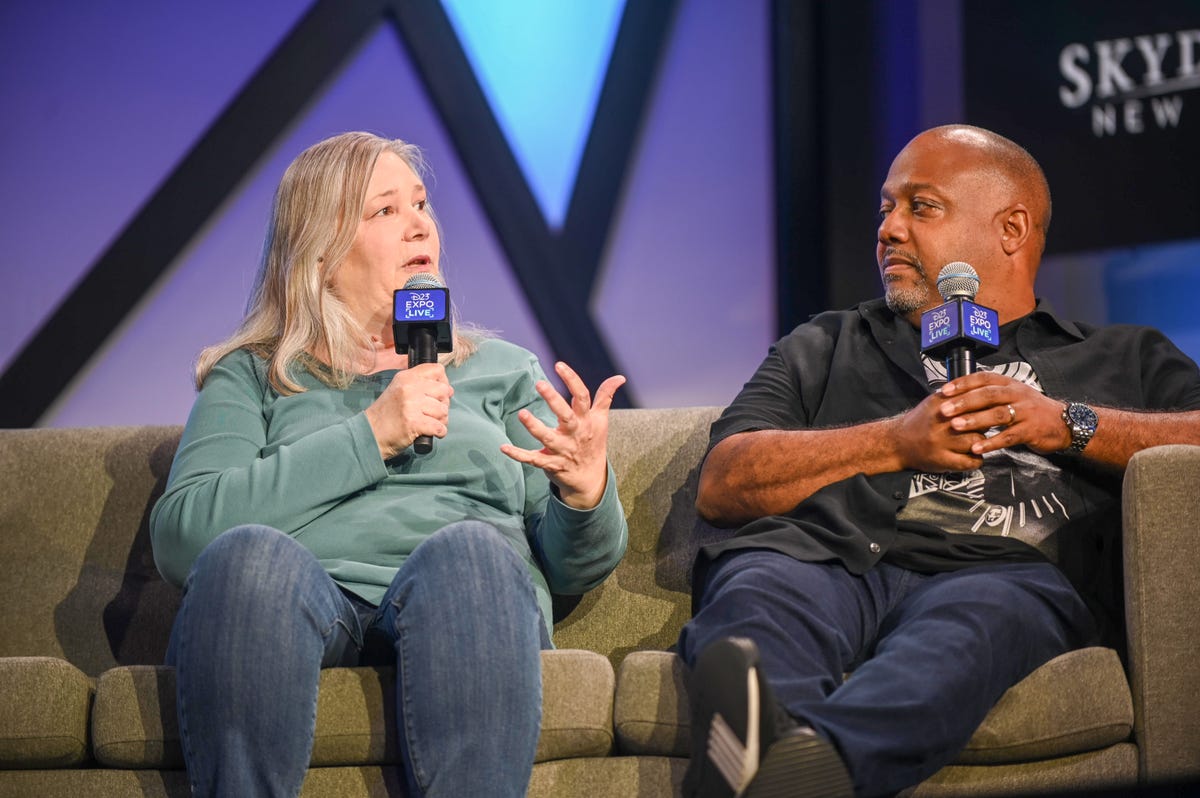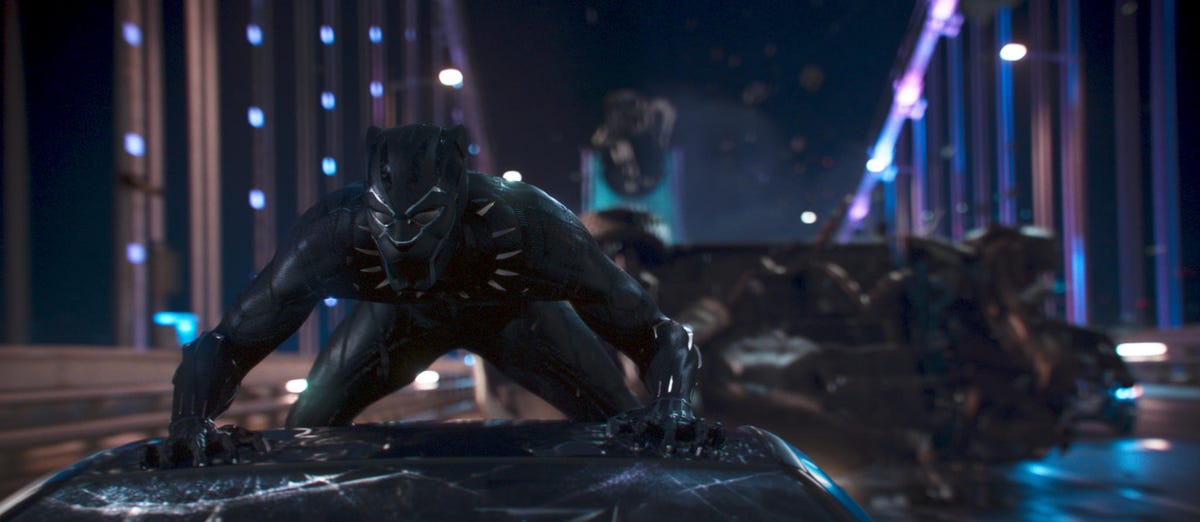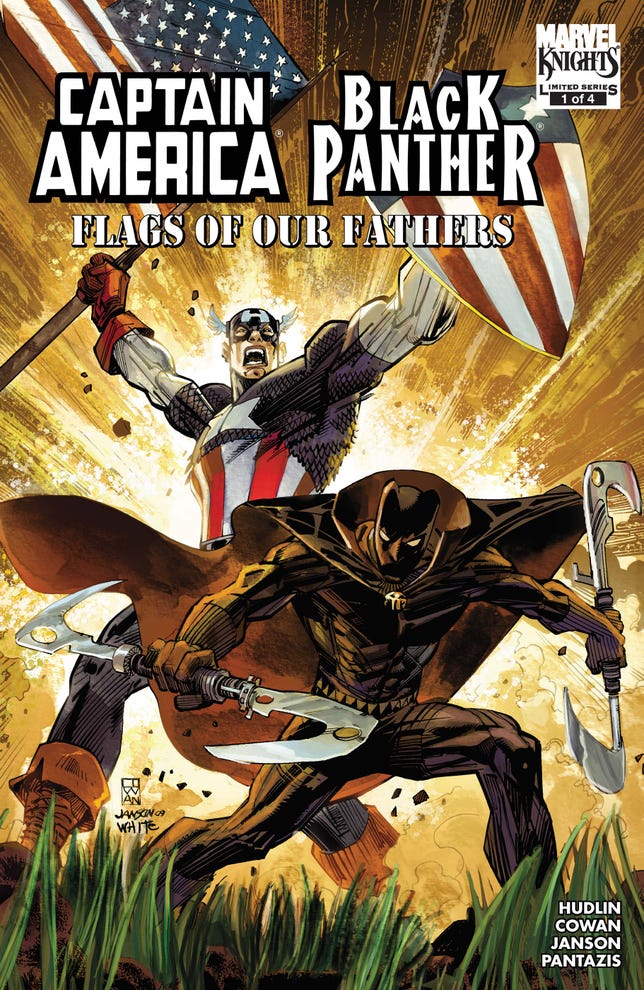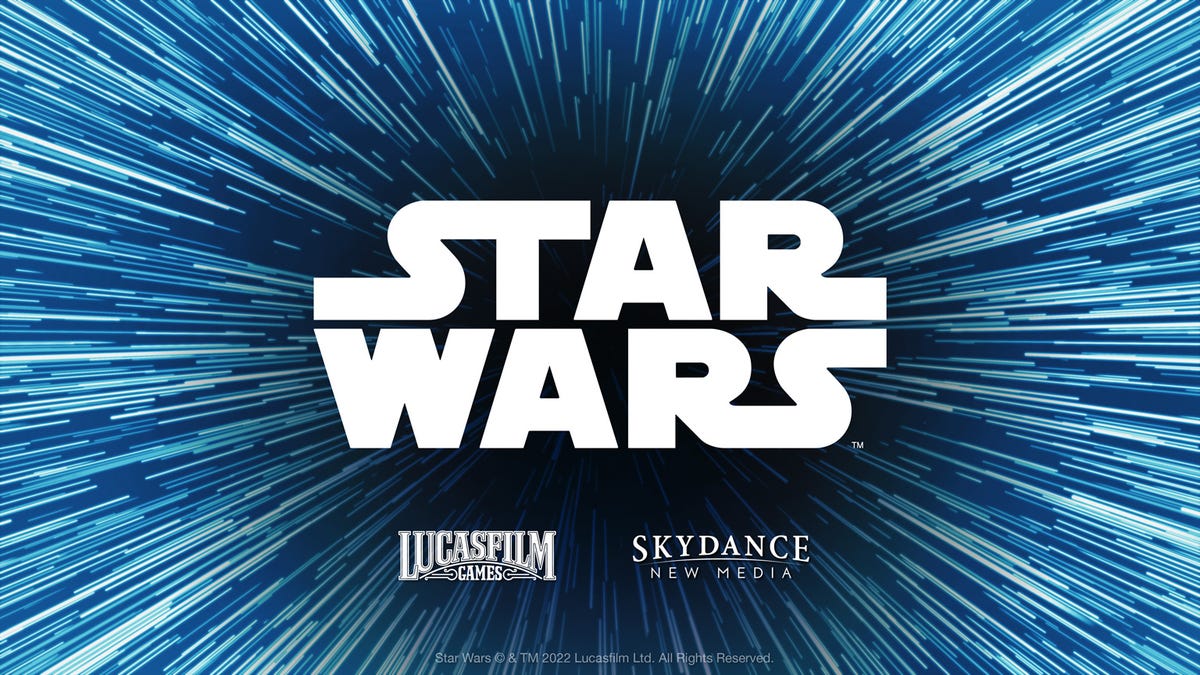The Captain America-Black Panther World War II teamup video game was among the most exciting announcements at Disney’s D23 Expo earlier this month. This Marvel-inspired game absolutely oozes potential, since it’s being led by a bona fide gaming legend: Uncharted creator Amy Hennig.
However, details about the game from Skydance New Media are thin on the ground — it doesn’t even have a title, let alone a release date or platforms. We do have a teaser trailer and cool tagline: “Four Heroes. Two Worlds. One War.”
We also know it’ll star a fresh-faced Cap/Steve Rogers; T’Challa’s grandfather Azzuri as the WWII-era Black Panther; Gabriel Jones, a US soldier and the only Black member of Cap allies the Howling Commandos); and Nanali, the leader of the fledgling Wakandan spy network). Cap and Black Panther are instantly recognizable, but Jones and Nanali aren’t nearly as well known.
The adventure will kick off in Nazi-occupied Paris, and terrorist group Hydra will be up to no good.
Hennig is the key factor elevating this project. Beyond her role in the early Uncharted titles, she was the writer-director behind series like Legacy of Kain (which holds a special place in my heart), as well as Jak and Daxter. Acting as story consultant is Marc Bernardin, who’s also a supervising producer on Star Trek: Picard and a writer on Netflix He-Men series Masters of the Universe: Revelation.
I confess to being quietly starstruck when I sat down with Hennig and Bernardin after the game’s D23 reveal. I asked them about the circumspect reveal, the Marvel stories they’ve been inspired by, how they hope to draw in an audience beyond hard-core gamers and the Star Wars game Hennig is working on. Here’s a transcript of our chat, lightly edited for clarity.
Q. This game’s reveal was fascinating. It was so circumspect. I was like, “They don’t have a title for this?”
Hennig: Yeah, who needs a title? We got a tagline. It’s super early still, so it would be way too soon for a gameplay trailer. And as far as not having a title goes, it’s a challenge — there’s no Marvel name to point to say “We’re making this.”
It’s gotta land like a Marvel Comics name that doesn’t exist yet — that’s no small feat when you’re talking about a company that’s been around as long as Marvel has and has used every word in the dictionary. Coming up with something that’s simple and feels like it’s been around forever, that’s gonna take some time.


Amy Hennig and Marc Bernardin talk about their Marvel game at Disney’s D23 Expo in September.
DisneySo we were like, “Do we delay a little, pulling the curtain back on our game, just because we have a whole process that’s going to take time?” Nah, just put a great tagline up there and let people call it whatever they want right now. We’re just so eager to share that it felt artificial to wait until we’ve gone through that whole process with all the interested parties — Marvel, Skydance, all of our other partners who’re gonna want to weigh in on that.
I’ve got CapPanther in my head for now. You certainly gave us a good sense of what the gameplay will be like, in that it will carry some of the DNA of your older games. Can you expand on that?
Hennig: What we’re making is firmly in the adventure space. We’re so focused on storytelling in these reveals and interviews that people can mistake that for being kind of a choose-your-own-adventure. No, it’s got all that two-fisted, moment-to-moment action of the kind of games I made before.


The action in Hennig’s Marvel game will be familiar to anyone who’s played Uncharted, but the developer wants to draw a wider audience in.
Naughty DogThe main difference is that we want to invite more people into play. Games have gotten increasingly complex, somewhat intimidating. Even for longtime gamers, you’ve gotta build yourself up: “OK, let’s play that game.”
Having something that is immediately inviting and intuitive, and with contextual controls that let you feel like you’re immersed in embodying these heroes, that’s the goal. So not only does it give you an immersive experience, but it also invites people might otherwise be intimidated to pick up the control.
That sounds a bit revolutionary.
Hennig: I think so. This is part of the challenge of building a team. I’ve been doing this for over three decades, and the team has an average of 20 years of experience in this area, but to bring people on who are ready to discard some of the dogma of what we’ve done in the past… [That’s] a fun place to be.
We’re doing super different stuff with the cameras, since this whole feeling of cinematic presentation is so important. It has to be as visually dynamic as cinema. The camera composition changes constantly — doing stuff you don’t see in games, but keeping the player in second-to-second control. There’s no roadmap.
I was going to ask you to compare it to something else, but it doesn’t sound like you can.
Hennig: Most of the DNA is from stuff that I made before, but we looked at all these other games that are doing interesting things with more contextual controls, like Quantic Dream‘s games [which include 2010’s Heavy Rain and 2018’s Detroit: Become Human]. But those are very different kinds of games. We’re still making a traditional AAA action-adventure game but in a way that should be more intuitive to players.
Non-gamers and casual gamers will be able to grapple with the controls right away. For experienced gamers, they’ll immediately be able to figure out where the depth is and combine certain moves. It’s about maximizing experience, not about beating the game; feeling like you’re in this flow state, embodying these heroes and being carried by propulsion of the story as opposed to feeling like you’re trying to conquer it.
So it’s less of a mechanical experience?
Hennig: Less of a tactical mechanical experience. With so many games, there’s an admirable effort to try to replicate the core fantasy of being a hero, but so rarely do you get to do so because you’re so tactically engaged and there’s a lot to manage.
We wanted to make something where you can pick up the controller and the game meets you where you are, interprets what your intentions are and honors them. It shouldn’t be so hard.


The 2018 Black Panther drew in an audience beyond superhero fans.
Marvel StudiosBernardin: When I first spoke to Amy about joining this team to help guide and build the story, she was very excited about the idea that because it’s Marvel, we were gonna get a massive audience who just wanted to play because they love Marvel — it’s the most popular IP [intellectual property] on the planet.
So that’s a bunch of people who maybe have never played a game before. Just like my mother had never seen a Marvel movie before Black Panther. It’s about finding as big an audience as possible, figuring out how to invite them to the party and not confronting them with 800 buttons.
The ensemble cast made me assume this will be a co-operative multiplayer game, but that’s not the kind of game I associate with Amy Hennig.
Hennig: We want to disabuse people of any of the wrong notions about the game — this is a single-player game, and so the four characters are all playable at different points in the story. Like a TV show or a movie, where you’re cutting between different characters. Because that’s the normal way to tell the story that games rarely do.
From She-Hulk to Black Panther, 12 Marvel Movies That Never Made It
So there are key points in the story based on what’s happening and what these characters are trying to accomplish in parallel or even working at odds. That raises the stakes. And we can cut back and forth between those characters, even really quickly cut back and forth, and be really creative like that.
That really necessitates that this be a single player experience. It’s not like you’re choosing which character to play, it’s not like you’re playing co-op multiplayer. There’s a… I kind of hate the term linear story, because I always try to make games that feel widely linear and have lots of player agency, but the story has a beginning, middle and end, with landmarks in between.
The character switching makes me think of Legacy of Kain: Defiance [the 2003 series finale, which saw you jump between protagonists Kain and Raziel]. Is that a reasonable comparison?
Hennig: It’s not a bad analogy — it’s coming from the same place. Good storytelling often captures different perspectives. You may have one protagonist, but it’s not told entirely from one character’s perspective.
You’re sort of jumping around between the characters in the story… very different than what we did in Uncharted because that stayed with the protagonist. You don’t even cut away to what the villains are doing.
We’re pushing for this idea, like what we achieved with Uncharted, of this shared living room experience where the non-gamers in the family are just as invested.
We also want the people to be like, “I want to try,” and you’re passing the controller around, playing it together. We don’t want it to feel like it’s this isolated experience where you slink off to play this game — it should be something a family would do together just like they might watch a show as a group.
I slinked off to play many a game as I grew up, I still kind of do. But gaming has become much more mainstream in the last decade or so. And I suppose this is about making it more accessible again?
Long term, just to get kind of philosophical on you, I think we’re inevitably moving towards this kind of stunning material existing on a streaming service and just getting Trojan-horsed into our homes. And our industry is gonna get transformed just like music streaming transformed that industry.
If a game like this was one click away, on a subscription service you’re already subscribed to, how would you engage with it? How would we be welcoming you frictionlessly into that experience? We’re still in a console world, we’re still designing a console game with a pad, but we’re also thinking about [the streaming] world. We’ve got to meet players where they are, in terms of their comfort, their experience level, and where they’re playing. And make the gameplay so intuitive that they can literally just start playing without any obstacles.
That doesn’t mean making dumbed-down games at all. It means we should be inviting everybody in. On a deeper level, experienced gamers might really understand how they can choreograph their experience in an even more satisfying way that rewards their skill.
World War II is a surprising time to set it in, especially with Cap and three Black characters. Can you talk about the dynamic they’ll have in that era?
Bernardin: Once the decision was made that it was going to be a Cap and Black Panther story, it was gonna be about these two worlds colliding. To bring Azzuri (T’Challa’s grandfather) from Wakanda and Nanali, the first agent of its fledgling spy network, to the West.
Then we needed a foil for Cap, who has similar experience to Cap’s in the war — different but still complementary. The idea of [a Black character like] Gabriel Jones meeting a king of Wakanda, to discover that [a technologically advanced African country like] Wakanda exists, having grown up in the ’20s in America, and then he’s in Europe during the war. What must that be like, to see the possibility? The conflict is so interesting,
We could’ve put an Irish American soldier like Dum Dum Dugan or a Japanese American one like Jim Morita in, but none of that was as interesting as Gabriel Jones discovering that Wakanda exists and then wondering “Why can’t I go?” He’s as as enarmored with Captain America as everybody else but able to point out “Y’know Cap, it ain’t like this for everybody.”
I can’t visualize what Wakanda was like in that era? Is this completely new territory? I’m sure the comics have explored it at some point.
Hennig: It hasn’t been deeply explored. One inspiration was Reginald Hudlin’s Flags of Our Fathers [a 2010 Captain America/Black Panther WWII teamup story]. He explored this idea of a threat coming to Wakanda, with Steve and the Howling Commandos America chasing the threat there and colliding with Azzuri, the Black Panther of the time. This was a really critical story [for us].


Captain America & Black Panther: Flags of Our Fathers serves an inspiration for the game.
Marvel ComicsBernadin: There are references in flashbacks, in a bunch of different comics. But it was fertile ground, like nobody had tilled the soil yet. So we tried to figure out how far ahead of the rest of the world Wakanda is at any given time — is it 10 years? 50 years? 100? Do they have flying cars? And then throttling back so that they still have flaws and weaknesses, and we’re not giving them magic bullets that can solve every problem.
I like to think it looks like the ’90s — Wakanda of the ’40s is what the West looks like in the ’90s.
Bernadin: Very grunge.
Is this set in an existing continuity? I assume this is a whole new thing.
Hennig: Yeah, in Marvel Comics, there are lots of realities and stories to be told. The creative team at Marvel doesn’t want people bound up with existing canon and how you fit inside of it. It’s more of a gut-check to make sure it doesn’t feel like you are fundamentally contradictory — something that feels true about these characters and this world. People can be coming to this game just as MCU fans, comic fans or whatever and should feel like it knits together those experiences.
Bernadin: It doesn’t contradict anything you believe to be true. If we get the audience we want for this game, it’s a lot of people who’ve never played before, who don’t understand that siloing of game space versus MCU space — it can all be one thing. In fact, it doesn’t hurt if you believe that it is. Suddenly, you’re like, “Oh, this is not the first Black Panther that Steve Rogers has met. Cool.”
Hennig: It’s an ensemble of two superheroes and two non-superheroes. We didn’t want to have four superheroes, we wanted to have two people who are normal; that raises the stakes for them and for the superheroes who have these squishy characters alongside them. It’s a more interesting ensemble than too many superpowered characters.
We also got to take some characters who’ve maybe been sidelined and move them into the foreground. Nanali was very much in the background [in her comic appearances], that was almost a complete blank slate for us to play with. But we love the fact that instead of totally inventing a character, we start from the name and go from there.
Since you’re this game’s story consultant, Marc, can you tell me about your history with these characters?
Bernardin: My history with Captain America goes back to the 1979 TV movie, which I watched because I was a huge fan of The Incredible Hulk show. But I’ve been a comic reader since — I go pretty deep on both Marvel and DC, but mostly Marvel. Encountering Black Panther and Steve Rogers was always just part of that experience. I was never a huge fan of either until much much later — until Ed Brubaker’s run on Captain America, inventing the Winter Soldier and all that stuff.
The Ta-Nehisi Coates run on Black Panther was my entry point [for that character], which then sent me back to the Christopher Priest run and then Reginald Huldlin run.
But they came together as a pair for me in the MCU, particularly in that Avengers: Infinity War scene where the bad guys are breaking through the gates of Wakanda and the heroes have to go out and meet them. The two people at the front of that push are Steve Rogers and T’Challa, the Black Panther. They’re the guys who will always run to the fight first — not just because they’re faster than everybody else, but because that’s who they are.
[I like] the idea of using those two characters as sort of proxies for telling a story about first contact [with between the US and Wakanda] about a war, about worlds colliding.
Amy, can you say anything about that Star Wars game Skydance is working on? I assume it’s still a long way off.
Hennig: We’re still a growing team, and we’re still setting up our pipelines and finding our feet. So it’s not like we’re trying to work on two things at once.


Skydance New Media is also working on a Star Wars game, but it’ll likely be a while before we see anything beyond this teaser image.
LucasfilmWe’re in continuous conversation with Lucasfilm about this thing, which is up next in the queue, what kind of story we want to tell and how that relates to what we’re doing now, in terms of the technologies and the mechanics that we’ve setting up and how those philosophies carry over from one to the next. So it’s definitely in mind, but obviously Marvel is No. 1 right now.
Can you say when we might hear about the Marvel game again?
Hennig: We need to go dark for a little bit. We wanted to just get a peek out there, put enough little clues and tantalizing tidbits in those shots to get people chattering. But we just gotta go heads down until our next next reveal, which will be gameplay, so we’re working hard on all that.


